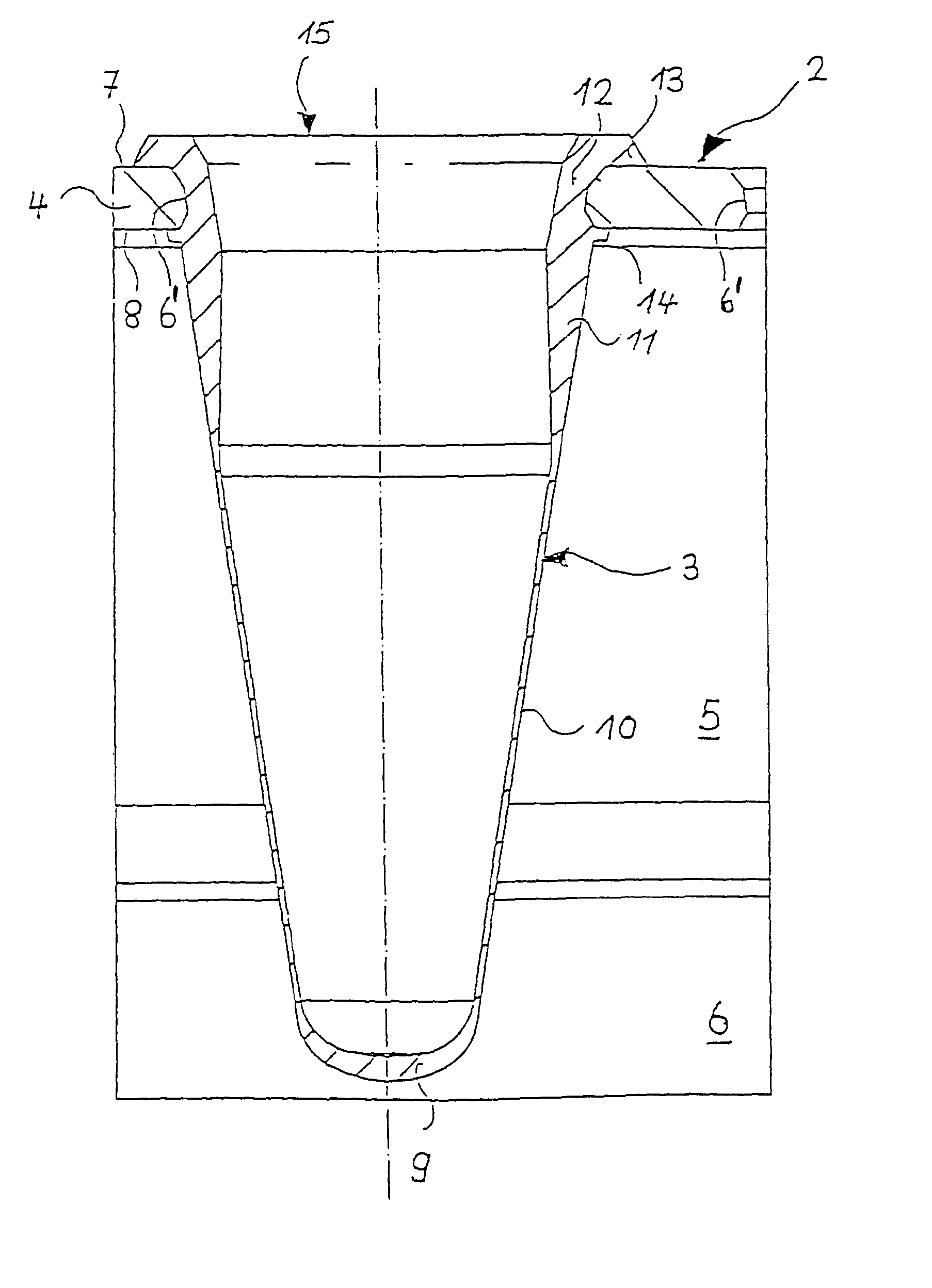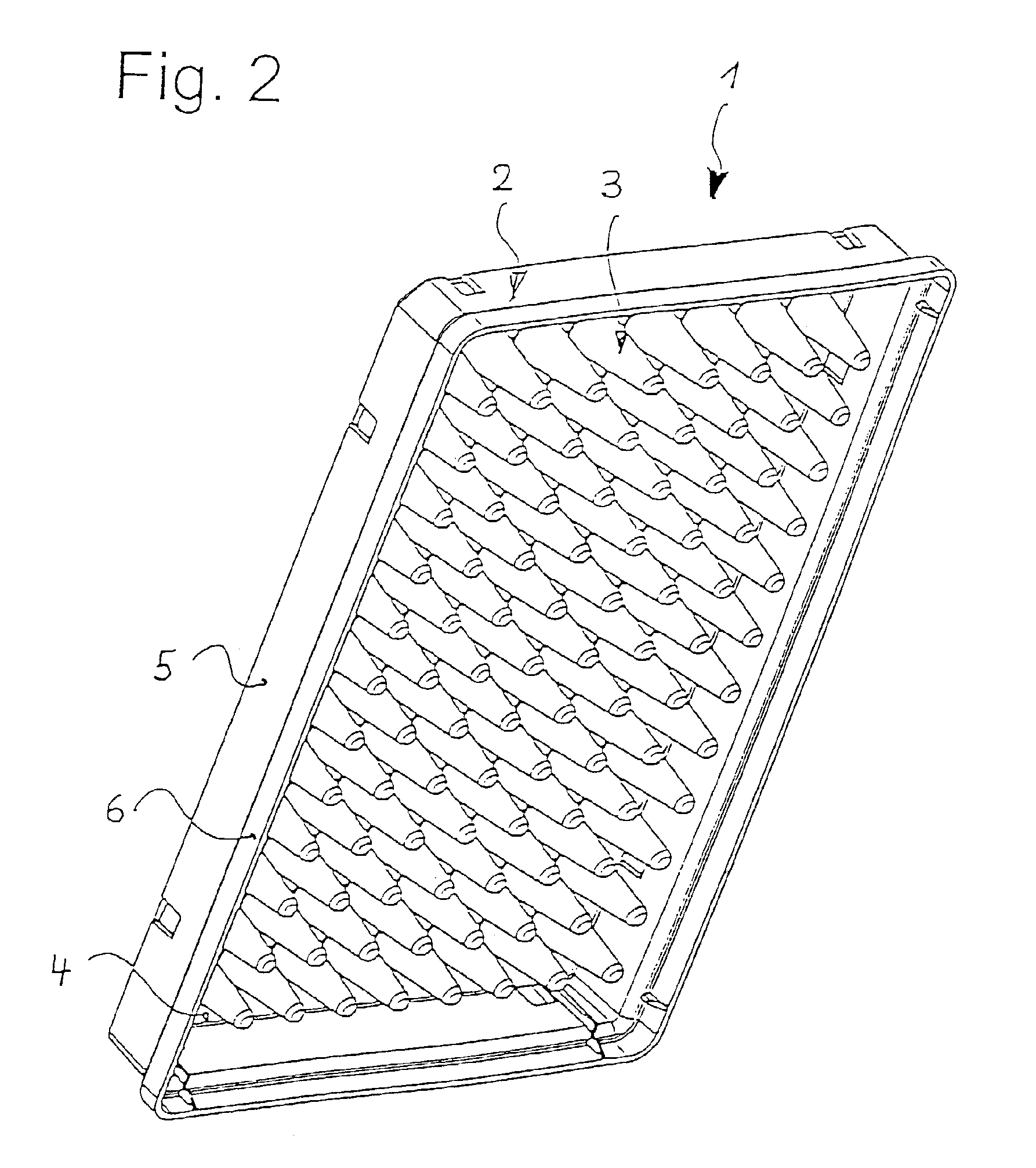[0014]Hence, the inventive microtitration plate is made of a single plastic only. Unlike conventional single-component microtitration plates which are completely molding in a single injection molding process, the inventive microtitration plate has the frame and receptacles molded to each other in two injection processes. This makes it possible to meet the requirements made to the frame and receptacles by giving the frame and receptacles a particular configuration and employing molding processes specifically adapted thereto while using a single plastic only. Injection molding to each other allows to achieve short flow paths of the plastic material in the frame and in the receptacles, which helps to achieve an increased injection pressure and to mold the contours of the frame and receptacle more easily. Thus, the receptacles can be molded to have particularly thin walls, specifically for high heat conductivity in view of their use in the PCR. Further, the relatively thick-walled design of the frame which can even be stiffened by ribs and other structures may make the microtitration plate suitable for being handled by an automatic device. In addition, the microtitration plate has the advantage that the receptacles may be injection molded only after the plate is molded and undergoes shrinkage, which allows to achieve microtitration plates which are particularly stable dimensionally. Moreover, the plastics of the frame and receptacles can be fused to each other at the injection molding points (points of injection) in the area of the holes so that the frame and receptacles are connected in a material fit and, thus, are connected to each other particularly firmly. This can also be accomplished by melting on the plastic which has been molded first and has solidified already, by means of the heat of the plastic which is molded later, which causes it to be fused to the second plastic.
[0016]As mentioned previously, molded the receptacles to each other in a direct way makes possible very short flow paths of the material in molding, which allows to achieve particularly small wall thicknesses of the receptacles. These are preferably in the range of about 0.05 to 0.25 mm and, in particular, may be about 0.1 mm. This favors heat transfer. For this purpose, the receptacle bottom of each receptacle has provided thereon a molding point from which the material fills a first wall portion of a reduced wall thickness and an upper wall portion connected to the plate. It is preferred that the upper wall portion be designed as a collar of an increased wall thickness, which allows to manufacture the microtitration plate at particularly low tolerances.
[0017]Hence, since the frame and the receptacles are molded in two steps the best solutions possible will be achieved with materials which do not necessarily correspond optimally to the desired functions of the frame and receptacles. Higher rigidity, better planarity, a lower tendency to distortion, and smaller tolerances are ensured by the configuration of the frame and a molding procedure adapted thereto. It is preferred that the frame of the microtitration plate be provided with a bordering protruding from the underside which enhances stability, may form a surface to stand on, and offers a surface to be clasped by the automatic device. It is advantageous for the frame to have several edge-sided molding points (about four to six). The extremely thin walls for better heat transfer are achieved by moulding the receptacles separately. No frame is filled via the receptacles so that the full pressure gradient is available only for one receptacle each.
[0020]Finally, according to an aspect, the plastics of the frame and receptacles are of different colors. A differentiation is possible here, in particular, by coloring the plastics black and white for the frame and receptacles, respectively. For instance, this makes it easier to optically check the position of the microtitration plates and receptacles.
[0022]Generally, the sequence of molding the frame and receptacles is random. For manufacture at particularly low tolerances, it is preferred to mold the frame initially and the receptacles subsequently. This has the advantage that the frame first may undergo a certain shrinkage or reduction in volume before the receptacles are molded thereto. This is beneficial, in particular, for crystalline or partially crystalline plastics such as polypropylene which undergo heavy shrinkage following the injection molding process. The time interval from molding the frame to molding the receptacles thereto may be chosen so that the shrinkage of the frame (by cooling it down) essentially is effected completely. Once the receptacles are molded on shrinking techniques virtually do not impair the dimensional stability of the microtitration plate any longer. It specifically is the local tolerance of the receptacles which, thus, can be confined to very low values (about±0.15 mm around their theoretical positions). This makes it easier to introduce proportioning needles with no wall contact.
[0023]It is particularly advantageous here if the upper wall region of the receptacles is designed as a collar of an increased wall thickness because the collar may compensate for hole position tolerances that have remained during molding.
 Login to View More
Login to View More 


